Ron Werner is a photographer who captured day-to-day common activities in New York, specifically in City Island. His family arrived to the USA by running away the nazis from his mother Austria. He opened a gallery called Focal Point Gallery to show his works at the beginning and finally he opened it to other artists, not only from the photo field but also from other artistic areas. Focal Point Gallery has evolved from an extremely large space, in which he also lived there, to a smaller one with impressive windows throughout which he used his camera in an efficiently way. Among all his photos, people with bikes emerge as icons. He affirms that he takes photos of bikers because it gives back memories when he was a boy and enjoyed pedaling.
Category Archives: Art
Critical Mass songs
An important part of the Critical Mass and most of the citizen demonstrations is music. Music and songs enhance spirit and turn people into good mood. As it comes to the Critical Mass in Valencia (Spain), here you have some songs and their translations into English. I know they do not sound as funny as in Spanish, but this way you can get an idea of their messages:
– No cuesta un duro
y pone el culo duro:
It doesn’t cost a penny
and gets your butt hard
– La bici en el trasero
y no en el trastero:
Bike in butt
and not in storage rooms
– Mi bicicleta no la cambiaría
ni por la moto de la policía:
I wouldn’t change my bike
even by the police motorbike
– La vida en la bici es la vida mejor
la vida en la bici es la vida mejor
sin gastar
sin gastar
sin contaminar
sin contaminar
poooor la calzada mejor
poooor la calzada mejor
Life on bike is the best life
life on bike is the best life
without wasting
without wasting
without polluting
without polluting
beeeeter on roads
beeeeter on roads
– Tanto coche
es un derroche
So many cars
are a waste
– Los coches oficiales
que vayan a pedales
Should the official cars
go on pedals
– Viva la bici
la hay donde quiera que vas
viva la bici
es lo que nos gusta más
con más gente a favor de bicis en cada pueblo y nación
habrían menos coches y motos
y menos contaminación
Long life bike
it’s everywhere you go
long life bike
that’s what we like the most
with more people in favor of bike in every village and country
there would’ve been less cars and motorbikes
and less pollution
– Carril coche ya
por toda la ciudad
Car lines now
all along the city
Fernando Traverso
In March 24th, 2001 actual size, black bicycles started appearing in Rosario, Argentina. At the beginning, it was a surprise since nobody knew who had painted them or whether they had a special meaning. Then, one day it was discovered that Fernando Traverso had made them. Fernando Traverso is a plastic artist who militated in the Juventud Peronista in his youth at the same time the bloody dictatorship of Jorge Rafael Videla took place. Among the abundant crimes it committed such as economic and juridical issues, there was the multiple human rights violations.
Fernando Traverso painted 350 black bicycles and this figure links with one of the darker episodes in the Rosario history. 350 is precisely the number of disappeared people from Rosario under the dictatorship. The Argentinian repression is known first for kidnapping people, then for torturing and finally for disappearing thousands of Argentinian.
There is a red number bellow every black bicycle indicating the number of bike in the series. Not surprisingly, cycles play a central role in this Traverso work. The reason why is that is because an episode in his youth. One day in the grey streets of the dictatorship, he was walking when he came across a friend who was riding a bike. Traverso surprised since he did not say hello to him and after a few minutes he found his friend’s bicycle locked to a tree. The next day, the same bike remained in the very same spot. This detail impressed Fernando Traverso and after some time he determined his friend had been a victim of the dictatorship. He had been murdered.
The project was awarded by the Museo Municipal de Bellas Artes Juan B. Castagnino in december of 2003.
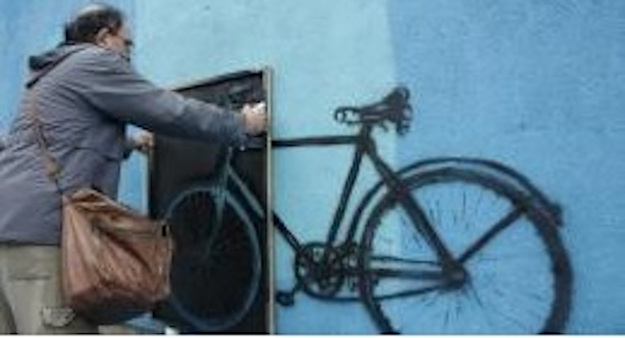
Frank Zappa
Frank Zappa is known for being a musician, songwriter, composer and bandleader. As an exponent of the satire American culture, his work is characterized by nonconformity, sound experiments, musical virtuosity and improvisation. If you are asking yourself what is one relation of Frank Zappa with bicycles, just go on reading.
Do you know that the first TV appearance of Frank Vincent Zappa he played… two bikes as musical instruments? It sounds crazy, but I promise it is true. He appeared on Steve Allen’s syndicate late night show in March 27th, 1963. Precisely, he used a bow borrowed from the band’s bass player and drum sticks. Then, the twenty-three year old musician continued by plucking, banging and bowing the spokes of the bikes. As a result, he produced funny, strange sounds from his innovative instruments. Indeed, he announced he had played bicycles as musical instruments for two weeks at the beginning of the performance, as a clear expression of the humor he showed.
Alireza
Some bike-fantasies deal with the possible relationships of some historical people no matter whether they enjoyed a bicycle or not. Just imagine how it could have been as it comes to King George, Joan of Arc, Gregor Mendel or Grace Hopper. The Iranian painter Alireza Karini Moghadam fantasizes with Van Gogh.
Van Gogh is known for being an impressive painter as well as for suffering psychological problems. Regarding this, some people thought he was always in bad mood, although this is not true. Alireza knows it and tries to express it in their paintings. Imagination paves the way. Indeed, thanks to his deep studies on Van Gogh, he is convinced that the painter loved life and thus paints him with a smile on the same landscapes and similar paint techniques. Vegetables capture most of attention, similarly to the yellow and blue colors, and of course Van Gogh himself. Moreover, Frida Kahlo, Kanagawa, Leonardo da Vinci and Edvard Munch influence him.
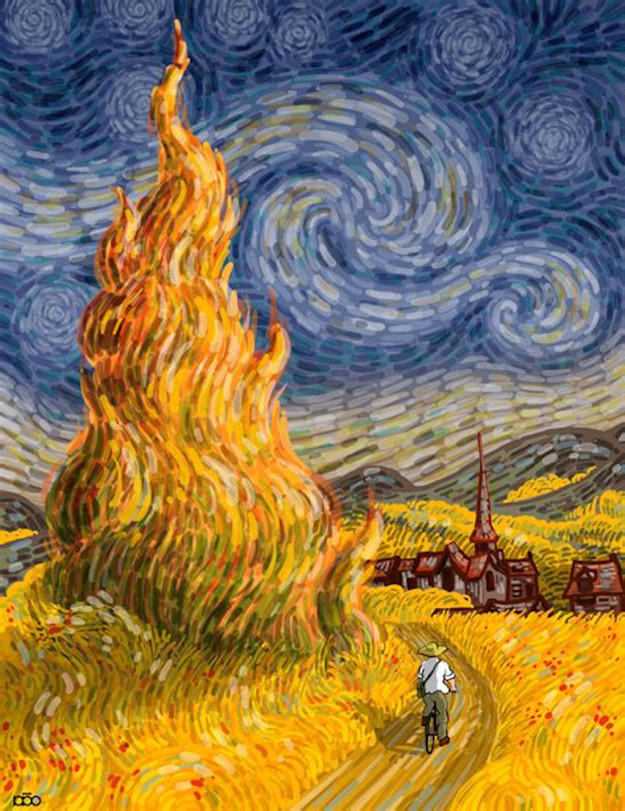
Stolen childhood
The New York photographer Lewis Hine took photos from child messengers at the beginning of the XX century. He showed how widespread child labor was at that time as well as some other habits like child smoking that we consider disturbing today. These children were used as couriers to deliver goods from newspapers to medicines from small and big businesses. They worked as small ants coming and going which preoccupied the most progressive sectors in the American society.
In 1908 the National Committee for Child Labor hired the photographer and sociologist Lewis Hine in order to document the labor conditions of such small people. He traveled the USA for nine years with a humble equip consisting in a 13 x 8 cm camera, an unstable tripod and a magnesium flash. Such effort was the start of considering Hine a pioneer of social photography.
What Hine found was worse than he had imagined. Children suffered from leonine working conditions, starting working at the age of nine, they often pedaled until dawn and slept under a bridge. The luckiest ones combine school with long hours of pedaling. Some times they entered the worse neighborhoods in which arms dealers, drug addicts and pimps operated. Some others worked for unscrupulously bosses. Hine wrote a sentence in their photos which summarized what was behind every picture. This fact allowed people understanding the real feeling they passed on them.
The situations that Lewis Hine shot were extensible to both large cities such as San Francisco, Boston, Houston or New York to small localities, and no matter how big a firm was i.e. giants like Western Union as well as small courier business were involved.
After taking the photos, Hine presented them to the Committee which used them as arguments in order to reach the dreaming Keatings-Owen Law in 1916. This established restrictions as it comes to legal working age and work shifts. However the Supreme Court repealed it, the spirit of the original Law influenced the New Deal which did not allow for child labor in the 1930’s.
The history of Hine continued by being part of the Red Cross in the First World War which allowed him traveling in Europe and taking lots of photos. Nevertheless, he ended his days in the same poverty that had been denounced in his pictures. He left 5,000 photos which were donated to the Photo League by his son. The Photo League was dismantled in 1951 and the Museum of Modern Art of New York considered them as irrelevant and refused them even though the enormous social value they had. So discouraging. Finally, they were donated to the International Museum of Photography George Eastman House in Rochester where you can see some of them.
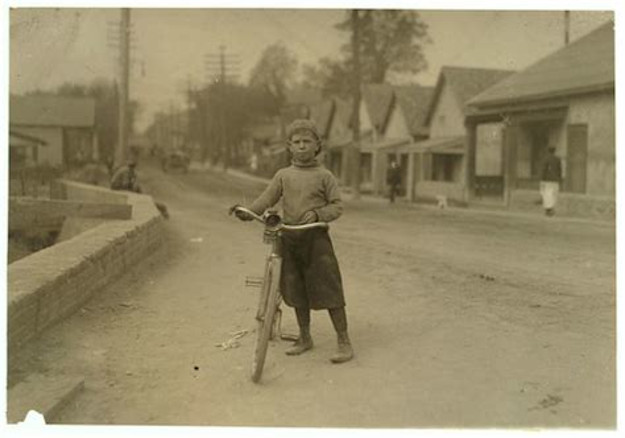
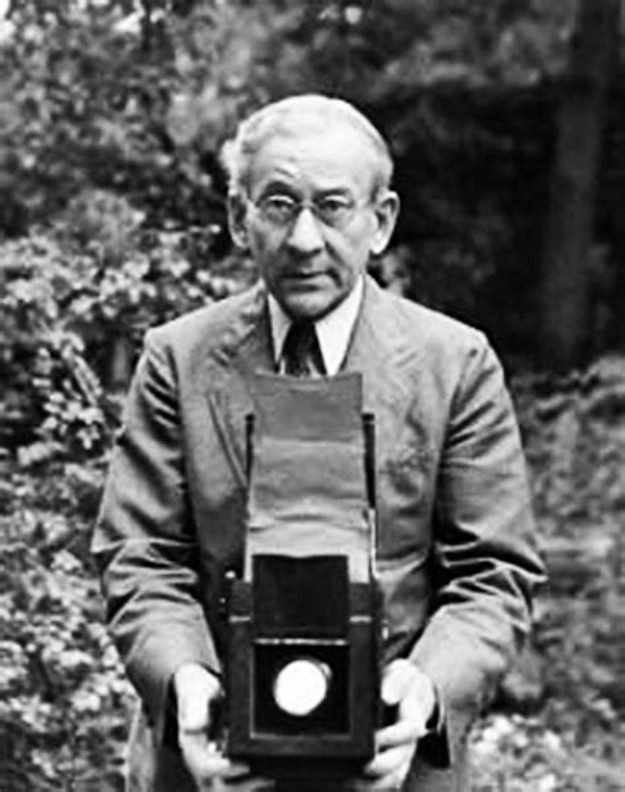
Arturello di Pópolo
Arturello di Pópolo is one of the most impressive bikeclowns. This Argentinian man plays a show which is highly influenced by La Bicicleta, an originally humor, piece of art developed by Joseph Francis Jinarek. This Austrian bicycle winner suffered an almost crash when competing, i.e. the handlebar of his bike came off from the frame at high speed. Fortunately, thanks to a series of pirouettes and his balance skill, he could stop his bike, put his feet on the ground and open his arms. The public clapped enthusiastically and La Bicicleta show was born.
Arturo Chillida del Pópolo (Arturello di Pópolo) knew about La Bicicleta when he saw Jinarek son (Joe Jackson Jr.) performing it in a awards gala with the best bikeclowns back in 1976. He was so impressed that decided to perform its own La Bicicleta.
La Bicicleta consists in a two-characters play in which no word is pronounced. This apparently drawback does not avoid collecting a lot of laughs. It starts with a beggar clown who finds an alone bike. After checking the owner is far, he retains it. His funny problems start from this point, and I am not going to spoil them.
The impact of Arturello di Pópolo on La Bicicleta is considerable as the original play lasts about twelve minutes, whereas the di Popolo adaptation extends for forty minutes. However, their essence remains the same: Making people laugh similarly as all the other bikeclowns like Álvaro Neil do.
Here you can see some of his shows.
Lea Schaepe
Lea Schaepe was born in Berlin, Germany, and has been practicing one of her passions for years: Acrobatic cycling (link a lo anterior). Such enthusiasm has made her one of the best in this sport with international recognition.

Indeed, Lea has won a dozen national competitions just in Germany and offers artistic cycling exhibitions and workshops in a lot of countries. You can follow her in her Instagram page.
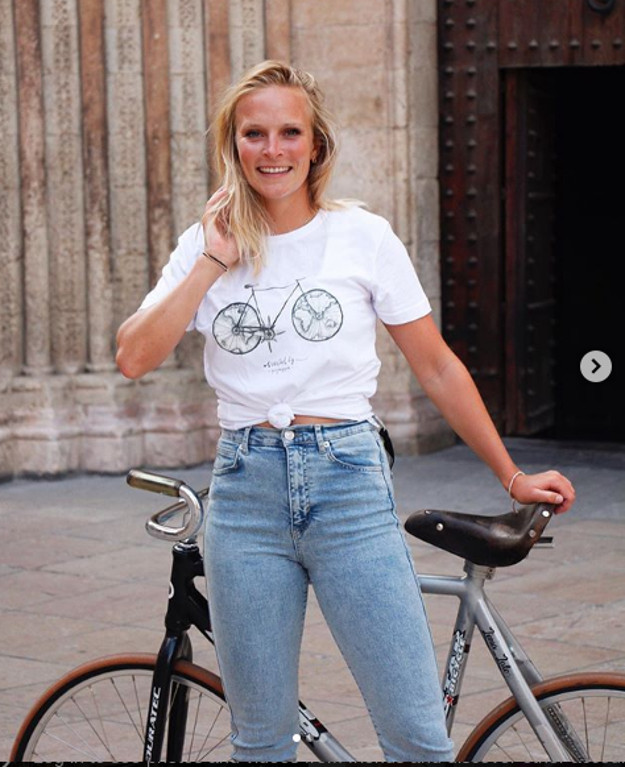
Lea learned to ride her bike in many unconventional ways while practicing this art year by year, primary in Germany. Those photos demonstrate how spectacular she is, and this is nothing compared to see her live and direct.
If you have the opportunity to see her in action, do not miss her and enjoy the time!
Artistic cycling
Artistic cycling is a 130-year-old sport. Yes, you have read 130 years. Cycling races began to hit their stride in Paris in 1868. Then, Nick Kaufmman showed audiences a different way to enjoy bicycles. He performed acrobatics on his bike. People were left with their mouth opened when admiring this new sport. Kaufmann expressed so much emotion and people helped by cheering him up, so that he made the connections he needed to organize a competition about artistic cycling. Indeed, he became the world champion of Professional Cycle Trick Riding, as it was known, in 1888.
This sport has been evolving over the years and now is really popular in Europe, and specifically in Germany. Competitors demonstrate several tricks indoors to judges, thus earning points as they perform. Similarly as ballet or gymnastics, participants compete in rounds of five minutes. Multi-person teams also compete by using multiple bikes, switch, ditch…
To perform the balancing tricks and backward motion, these artists use fixed-gear bikes with a gear ratio of 1:1, and tires of proportionate size. To enhance maneuver, the handlebars are similar to those used in racing bicycles, but upside-down in comparison. Moreover, the front wheel should be free to spin 360º.
By combining these outstanding bikes and long hours of practice, riders perform handstands, wheelies, body-surf, and attempt as many other tricks as they can in their allotted time. Hence, innovation is rewarded by judges who also take into account the number of tricks, execution, form and degree of difficulty.